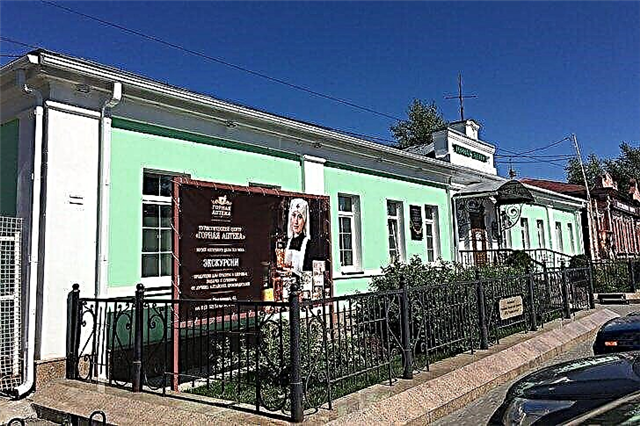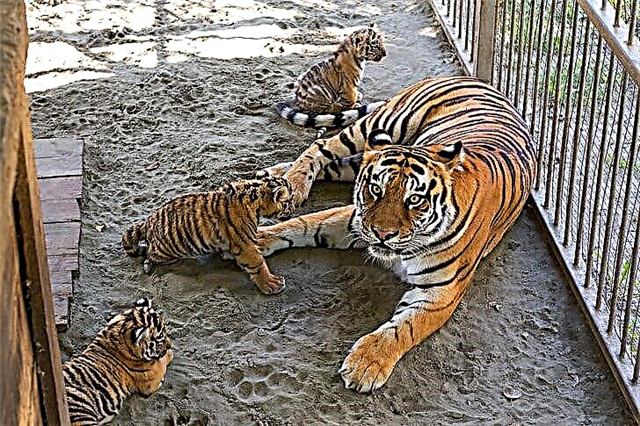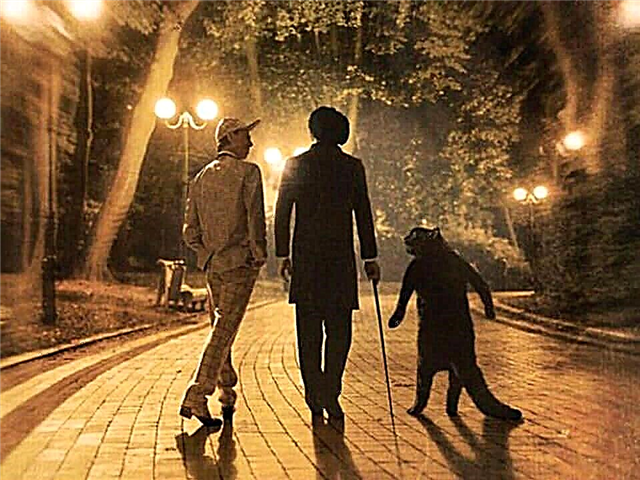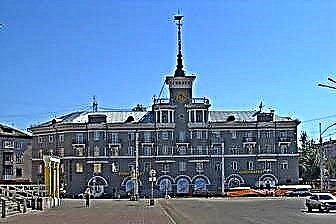The image of the city is a superposition of the provincial buildings of the past with modern trends. The city managed to preserve samples of wooden architecture, church facades and old administrative buildings. Among the buildings on almost every street you can find an architectural monument of the XIX-XX centuries.
The natural component is also important in the beauty of Barnaul. For example, the longest belt forest in Western Siberia is a great place to relax. Fauna lovers should go to the city zoo or take a ride to the village of Vlasikha and walk around the ostrich ranch.
Among the museums there are exhibitions and expositions of several directions: scientific, cultural, literary. There are also special excursion tours to get to know the city better.

The best hotels and hotels at affordable prices.
from 500 rubles / day
What to see and where to go in Barnaul?
The most interesting and beautiful places for walking. Photos and a short description.
Upland park
The territory began to be developed in 1772. This is how a cemetery appeared in the area between the Ob and Barnulka rivers. In the 30s of the last century, they almost completely got rid of it, breaking up a park in this place. An agricultural exhibition was held here in 1956. The fire and partial collapse of the coast brought the pavilions into a deplorable state. Now they are trying to return the park to its former splendor: they held a graffiti festival, began to build a temple.

House under the spire
Built in 1956 on October Square. The architectural style is Soviet classicism. In the exterior decoration of the building, stone plaster with mica was used. On the ground floor there is a grocery store, above - residential apartments with improved planning. The height of the house is 46 meters, of which 15 meters fall on the spire. At the moment, many communications are worn out, and the weather vane does not work either. Fundraising for repairs is underway.

House of merchants Yakovlev and Polyakov
It is recognized as an architectural monument of the early XX century. The two-storey building was built in the central area of the city in the Art Nouveau style. The masonry is red and white, arched and round windows, a spire is erected on the dome. The general harmony of the old buildings is somewhat disturbed by a massive four-storey building, which was added close to it in the 70s. There is no stylistic transition, so the merchant house began to stand out more.

House of merchants Shadrins
Built at the beginning of the 20th century on Krasnoarmeisky Prospekt. One of the brightest examples of wooden architecture in Siberia. The facade is decorated with carved inserts. The Soviet restaurant "Russian Samovar" was replaced by the more modern "Emperor". It has been under reconstruction since 2016. After the completion of the work, a catering establishment will reappear here. The house is included in the list of cultural heritage sites.

Mountain pharmacy
The building was recognized as an architectural monument in the 18th century. During the development of Siberia, there was a drug distribution point here. There was also a pharmacist's house, warehouses, a laboratory and student rooms. The tourist center is now based here. It has a museum that tells the history of pharmacy in the region. In addition, an exhibition of Altai pharmacists has been opened.

Museum "City"
Its history dates back to 2000, when a small exhibition was given premises at the library. By 2007, the museum was allocated two halls on Lenin Avenue. The exposition covers all the stages of the formation of the city in its present form, starting from the times when Barnaul was a mining settlement. Profiled lectures are also read here, for example, "Temple architecture of Barnaul at the end of the 18th - beginning of the 19th centuries."

Altai Museum of Local Lore
It is the successor of the Barnaul Mining Museum, founded in 1823. In 1913 the collection was moved to a new building - a former chemical laboratory, where it is located today. The total number of exhibits is about 150 thousand. Among other things, archaeological finds, numismatics, household items typical for Altai, as well as a unique model of a steam engine invented in 1763 are on display.

Art Museum of Altai Territory
The collection originates from a collection of works of art by the inventor Pyotr Frolov. He organized the art department at the local history museum back in 1826. Subsequently, part of the painting was lost, but in 1959 a full-fledged art museum was opened. The canvases were transferred here, including the Hermitage from the Tretyakov Gallery. The funds include about 13 thousand exhibits.

Museum of entertaining sciences "How-so ?!"
Located on Lenin Avenue. The interactive exhibition is divided into several rooms. Each has its own mini-show. For example, in a mirrored room, thanks to an optical illusion, one person can "multiply" and become a crowd. The guides will tell visitors a lot about soap bubbles, allowing them to consolidate their knowledge in practice. Scientific kits and constructors for every taste are also sold here.

Museum "World of Time"
The year of opening is 2008. 2 branches and an exhibition hall are united under one sign. The exposition consists of objects from different eras and places. Ancient coins and modern technical means can easily be nearby, on the shelves you can find mammoth teeth, household items of the Slavs, medieval clothes, and weights. Most of the exhibits can be touched. The showroom also hosts guest collections.

Museum "World of Stone"
Based on the mineralogical collection of Sergei Berger. The museum has existed in its current form since 2010. Here are collected samples of rocks, fossils and minerals from all over the world. Museum workers conduct walking tours, both around the city and beyond. Tours are especially popular in summer: the weather allows you to make long trips and see more interesting places at a time.

Altai Youth Theater
Officially founded in 1958 and emerged from an amateur studio that existed for several decades. During its existence, it has changed several addresses. The current hall can accommodate almost 500 spectators. The most successful period of the theater's existence is considered to be the time when it was headed by Valery Zolotukhin from 2003 to 2013. After the death of the artist, it was decided to name the theater in his honor.

Altai Regional Drama Theater
Founded in 1921. The oldest theater in Altai and one of the largest in Western Siberia. The current building of the theater was built in 1979, and in the middle of the 2000s it was completely reconstructed. There are two halls: the main one can accommodate 711 spectators, the “experimental stage” can accommodate 183 spectators. The theater has a museum. In 1991 it was renamed in honor of Vasily Shukshin.

Altai Theater of Musical Comedy
It was created in Biysk in 1960, and in 1964 moved to Barnaul. The first performance was the operetta "Rose of the Winds". Initially, it was planned to stage only musical comedies here, but the repertoire in different periods included works of other genres. In 1972, the theater moved to a new building on Komsomolsky Prospekt, where it is located to this day. The troupe regularly tours the cities of Russia, less often abroad.

Puppet theater "Fairy Tale"
Organized in 1938, initially it did not have its own building. The troupe toured different cities. After the war, the theater was closed and revived only in 1963. Temporarily, the artists settled in the Philharmonic. After 7 years, they received a permanent residence permit on Pushkin Street, where they remain today. Most of the repertoire is designed for children, but performances are sometimes staged for an adult audience as well.

GMILIKA
The abbreviation hides the Museum of the History of Literature, Art and Culture of Altai. Its doors have been open to guests since 1989. The funds contain more than 78 thousand exhibits. This includes the personal collections of cinematographer Shukshin, artist Roerich, writer Grebenshchikov.The museum building is an architectural monument of the late 19th century. There are three branches - memorial museums of artists Zolotukhin and Savinova and the poet Rozhdestvensky.

Intercession Cathedral
Founded in 1898 on the site where a wooden church once stood. The architectural style is neo-Byzantine, built mainly of red brick. The interior decoration is characterized by painting the walls with biblical subjects. Has 4 thrones. After the revolution it was closed, but the restoration began already in the 40s. For some time he was the only one in the city. In the first half of the 90s, a new bell tower was erected.

Nikolskaya Church
Built in 1906 by architect Verzhbitsky. It was located near the barracks and was considered a "regimental". In 1935, the temple was plundered, including the removal of the dome. A club was based within the walls of the church for some time, then the premises fell into disrepair. At the end of XX, reconstruction was carried out. The red brick building was renovated, a new iconostasis was installed, and the interior walls were painted.

Znamensky monastery
It appeared in 1994 at the church of the same name. At the same time, work was underway to restore the temple. Among other things, a new iconostasis was installed and the bell tower was opened. The first abbess of the convent is buried next to the altar apses. The monastery has several valuable relics, for example, the icon "Fadeless Flower", painted on Mount Athos in 1902, and a particle of the relics of the Monk Martyr Elizabeth.

Monument to V.M.Shukshin
Installed in the Leninsky district of the city in 1989. The opening was timed to coincide with Shukshin's 60th birthday. The author of the brass monument was Nikolai Zvonkov. The work took over one and a half years. The composition was assembled first in the workshop, and then in the workshop. Later, the sculpture was erected on a granite pedestal, and a square was laid out around it. Among other things, they planted the red viburnum. The "Shukshin Readings" are held here every year.

Monument to settlers in Altai
The opening took place in 2012. The author of the project is Oleg Zakomorny. This is the first monument in the country to celebrate the hard work of a migrant peasant. The composition was installed on a high pedestal. In the center there are two figures - an adult sower and a child following him. Behind them are trees, sun, clouds and birds. Each detail has its own semantic meaning, sometimes abstract.

Park "Emerald"
It appeared at the beginning of the last century on the site of a cemetery. Area - 40 hectares. In 1939, an artificial pond appeared. The park currently houses a planetarium. Its building is included in the list of architectural monuments and was in the past a church. In winter, ski trails are laid across the park. In summer, there are attractions and concerts. There is a car city where children are taught the rules of behavior on the roads.

Barnaul Zoo
It is located in the Industrial area in the picturesque park "Lesnaya Skazka". The official opening date is 2010. At the same time, the zoo developed from a living area formed in 1995. Area - 7 hectares. There are more than 140 animals and about 50 species of birds. Among the zoo's pets there are both typical representatives of the region and rare specimens, such as a peacock or Far Eastern leopard.

Ostrich Ranch (Vlasikha)
Located in the village of Vlasikha. You can visit any day for a reasonable fee. Although the ranch is open until 6pm, the hosts allow visitors to linger. There are many large aviaries on the territory. Not only ostriches live in them. There are plenty of animal species: rabbits, peacocks, camels, deer, chickens, geese, guinea pigs. Some can be ironed and fed. There are places for rest and lunch.

Barnaul belt forest
It stretches for 550 km along the left bank of the Ob. Width - from 8 to 10 km. The longest in Western Siberia. In addition to pine, there are birches and aspens. Among rare birds, the black stork can be distinguished. Popular hiking destination. Many recreation centers have been built in or near the forest. Thanks to volunteers, the territory is kept clean. At the junction with the Kasmalinsky belt forest, the Yegoryevsky reserve was formed.












